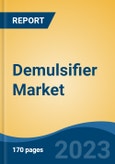Crude Oil is the fastest growing segment, North America is the largest regional market
Speak directly to the analyst to clarify any post sales queries you may have.
10% Free customizationThis report comes with 10% free customization, enabling you to add data that meets your specific business needs.
Key Market Drivers
The increasing global crude oil production and ongoing exploration activities represent a primary driver for the demulsifier market. As upstream operations intensify to meet the escalating worldwide energy demand, the volume of crude oil extracted, often in the form of water-in-oil emulsions, also rises significantly. Demulsifiers are essential in separating water from crude oil, a critical step to prevent pipeline corrosion, reduce transportation costs, and meet crude oil quality specifications for refining. Without efficient demulsification, the presence of water can lead to severe operational inefficiencies and damage to infrastructure throughout the value chain.Key Market Challenges
Stringent environmental regulations governing the toxicity and biodegradability of demulsifier formulations represent a significant impediment to the growth of the Global Demulsifier Market. These regulations mandate extensive research and development to create compliant products, directly increasing operational costs for manufacturers. Such requirements necessitate investment in new formulations and testing protocols, driving up the cost of bringing new demulsifier technologies to market.The escalating regulatory burden directly hampers market expansion by elevating expenditures for both producers and end-users. According to the American Chemistry Council, in the fourth quarter of 2023, 43% of chemical manufacturers indicated their regulatory burden had increased. This trend continued, with 38% of manufacturers reporting an increased regulatory burden in the second quarter of 2024, and over half expecting a further rise in the subsequent six months. This consistent upward pressure on compliance costs can constrain profitability, slow down the adoption of new demulsifier solutions, and limit overall investment within the demulsifier segment.
Key Market Trends
The global demulsifier market is significantly influenced by a pronounced shift towards bio-based and sustainable demulsifier solutions. This trend is driven by increasing environmental regulations and a broader industry commitment to reducing the ecological footprint of chemical processes. Manufacturers are investing in research and development to create products derived from renewable resources that offer improved biodegradability profiles. For example, research published in April 2025 highlighted that natural demulsifiers, sourced from plant extracts, waste oils, and biopolymers, are emerging as sustainable alternatives for crude oil demulsification, with studies in 2023 specifically evaluating the effectiveness of green demulsifiers on Nigerian crude oils. This indicates a move away from conventional petroleum-derived chemicals to more environmentally benign options.Key Market Players Profiled:
- Clariant AG
- Dow Chemical Company
- BASF SE
- Arkema S.A.
- Momentive Performance Materials, Inc.
- Schlumberger Limited
- Halliburton Company
- Baker Hughes Company
- Ecolab, Inc.
- Nouryan B.V.
Report Scope:
In this report, the Global Demulsifier Market has been segmented into the following categories:By Type:
- Oil Soluble
- Water Soluble
By Application:
- Crude Oil
- Petroleum Refineries
- Lubricant Manufacturing
- Oil Based Power Plants
- Others
By Region:
- North America
- Europe
- Asia-Pacific
- South America
- Middle East & Africa
Competitive Landscape
Company Profiles: Detailed analysis of the major companies present in the Global Demulsifier Market.Available Customizations:
With the given market data, the publisher offers customizations according to a company's specific needs. The following customization options are available for the report.Company Information
- Detailed analysis and profiling of additional market players (up to five).
This product will be delivered within 1-3 business days.
Table of Contents
Companies Mentioned
The companies profiled in this Demulsifier market report include:- Clariant AG
- Dow Chemical Company
- BASF SE
- Arkema S.A.
- Momentive Performance Materials, Inc.
- Schlumberger Limited
- Halliburton Company
- Baker Hughes Company
- Ecolab, Inc.
- Nouryan B.V.
Table Information
| Report Attribute | Details |
|---|---|
| No. of Pages | 180 |
| Published | November 2025 |
| Forecast Period | 2024 - 2030 |
| Estimated Market Value ( USD | $ 2.49 Billion |
| Forecasted Market Value ( USD | $ 3.06 Billion |
| Compound Annual Growth Rate | 3.5% |
| Regions Covered | Global |
| No. of Companies Mentioned | 11 |









